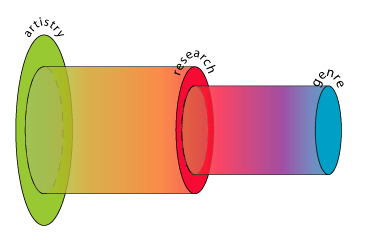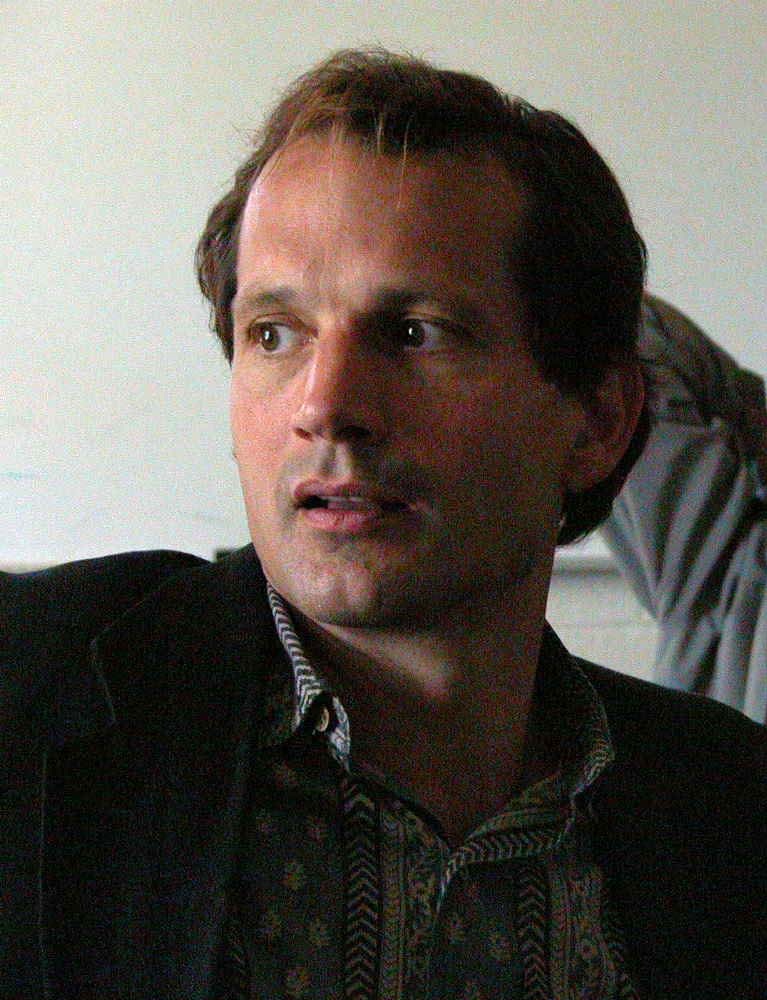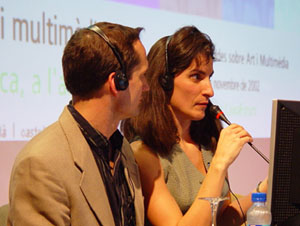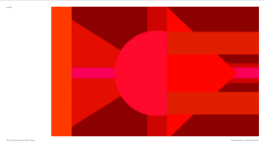At this edge, programmers are cooking up mischievous recipes that tap into the tremendous computational power of the silicon chip. Some craft a single line of code that generates an endless universe of shapes and colors; others write a single line that crashes your computer instead. Creators featured in this chapter include:
- Benoit Mandelbrot
- John Simon
- Jaromil
- jodi
Click to learn more about
Code As Muse.
Shown: Martin Wattenberg's contribution to CODeDOC.
At this edge, game designers fashion 3D worlds where the ethics and laws of physics are as malleable as the code they wield. What can we learn from the violence in most computer games--and from the independent designers who break the shoot-em-up mold? Games featured include:
- Grand Theft Auto and Three Hour Donut
- America's Army and Hezbollah's Special Force
- The Longest Journey and Three-Player Chess
Click for more about
Deep Play.
Shown: Final Fantasy X © Square Enix, all rights reserved.
At this edge, online authors avail themselves of automated forms of biography, from blogs to Webcams to Flash narratives, to refigure the self for the digital age. Works featured in this chapter include:
- Jennicam
- Wearcam
- Heavy Industries
Click to learn more about
Autobotography.
Shown: the (blogged) birth of Ada T. Norton.
At this edge, political designers develop software that sends overlords to jail, create galleries that confound judges ruling on copyright, build games to bankrupt belligerent ecommerce companies, or pay operatives to switch Barbie's and GI Joe's voiceboxes. Works in this chapter include:
- The Simcopter Hack
- Gallery of CSS Descramblers
- Toy War
Click to learn more about
Designing Politics.
Shown: Carnivore client by area3.
At this edge, creators chart flame wars on message boards, conjure apartment blueprints from words typed by visitors, weave love poems from anonymous contributors or musical compositions from search engine results. Works in this chapter include:
- Telegarden
- Visual Who
- Listening Post
- Slashdot
Click to learn more about
Reweaving Community.
Shown: Turns, by Margot Lovejoy with Hal Eagar, Marak Walczak, Jon Legere, and Charles Bae.
At this edge, biologists are fishing for paramecia, drawing pictures with rat brains, and unleashing evolving viruses on a computer network. Creators featured in this chapter include:
- Joe Davis
- SymbioticA
- Tom Ray
Click to learn more about
Preserving Artificial Life.
Shown: Joe Davis' modified e. coli specimens.
Presentations
- ARCO, Madrid, 15 February 2009
- Berkman Center, Harvard, 29 July 2008
- CRASSH, University of Cambridge, 24-26 April 2008
"Get hold of this fascinating and cogently written book and explore the far edges of art"

How has the boundary between art and non-art shifted in the Internet age, and what does that mean for design, activism, science, and other creative activities? This question is the subject of a Dario Moalli’s fall 2019 interview with Still Water co-directors Joline Blais and Jon Ippolito in the venerable periodical Hestetika (Aesthetics). The issue […]
New Media alumna Margaretha Haughwout invited Still Water co-directors Joline Blais and Jon Ippolito to explore the connections between different types of code and how they can be open-sourced, digitally and biologically, in a series of talks and workshops at Colgate University in November 2018. The backdrop for these events was Haughwout’s Colgate course “Code, […]
While the maker movement continues to gather publicity, one of its most critical dynamics seldom makes the headlines: the right to unmake. Now the College Art Association has published a call for presentations on unmaking and “Lego-like” creativity for its next annual conference in Los Angeles in February 2018. The practice of unmaking can be […]
Once dusty storehouses of antique patrimony, today museums are forced to re-imagine themselves for an age where culture is shared from smartphone to smartphone. Recent Still Water publications on reinventing museums for the 21st century are cropping up in anthologies like the International Handbook of Museum Studies and in interviews from The Library of Congress. […]
A Still Water project by Jon Ippolito aimed at linking thematically similar academic essays across the Web has been awarded an initial grant of $10,000 by the Thoma Foundation. Founding philanthropists Carl and Marilynn Thoma also hosted a presentation at New York’s School of Visual Arts last December to honor the inaugural recipients of the […]
The July discussion on the Yasmin email list focuses on MIT Press’s publication last month of Re-Collection: Art, New Media, and Social Memory by Richard Rinehart and Jon Ippolito, which has been called the first academic book on new media preservation. Re-collection examines the challenge posed by new media to our long-term social memory, examining […]
A picture may be worth a thousand words, but in this case a single line of code is worth 300 pages and 70 illustrations. Still Water Senior Researcher John Bell is one of the authors of a new MIT Press book that scrutinizes a single line of code from the Commodore 64. The line in […]
Drawing on the forthcoming book New Media and Social Memory co-authored with Richard Rinehart, Jon Ippolito speaks on “Wind, Rain, and Ambient Preservation” at ISEA 2011 in Istanbul. “If you take the Christian bible and put it out in the wind and rain, soon the paper on which the words are printed will be gone. […]
Waterfall Arts presents Still Water Co-Director Joline Blais talking about her work in ecology, the New Commons, and cross-cultural networking on Monday 26 April at 7pm. Artist Lecture Series: Joline Blais Waterfall Arts 256 High Street, Belfast 207-338-2222 More information at Waterfall Arts
Still Water is pleased to announce the publication of 60: Innovators Shaping Our Creative Future, a landmark book on the occasion of the 60th anniversary of renowned art and design publishing house Thames & Hudson. Still Water co-directors Joline Blais and Jon Ippolito penned the new media section of this book, which profiles five of […]
Far from the studios and galleries that sheltered art in past centuries, creative people sitting at computer keyboards are tearing apart and rebuilding their society's vision of itself. Though they may call themselves scientists, activists, or hackers rather than poets or performers, today's electronic visionaries are redefining art for the Internet age.
Art's recent eruption in fields as diverse as artificial life, computer games, and community activism reveals a seismic shift in the role it plays in society. No longer content to sit on a pedestal or auction block, these works infiltrate stock markets, sway court cases, and network bedrooms, reaching across the globe to expand the edge of art.
But is every instance of creativity, from shrewd e-commerce ventures to clever toy designs, equally valid as art? Has the distinction between art and non-art become irrelevant in an age when art and science, commerce and fashion are all whipped together in the global culture blender we call the Internet?
The answer is no, though the reason has little to do with the traditional rationales for defining art, be they to distinguish high and low culture or to validate creative programs in academic settings. Art may be temporarily out of place, but society needs to make a place for it. Because society needs art to survive.
This is a time of tumultuous technological change. On any given day, a news outlet like Wired.com is likely to report on the outbreak of a new computer virus, the development of a new surveillance technology, and a new technique for growing bodily organs. Science has always offered us a future, and sometimes even a promise to repair the dangers it has unleashed on us in previous generations. But in an age when technology seems increasingly to have a mind of its own--even if that "mind" is actually the product of global economic forces--art offers an important check on technology's relentless proliferation.
How might this be done? What functions can art deploy to help us defend ourselves against technology's assault? The biological body defends itself from foreign invasion via the immune system, more specifically through the action of antibodies. Perhaps the kind of art we need in such an age is one that can support the social body as antibodies support the individual one.
If we look at how digital art functions in our society, we can discern remarkable parallels to the actions of antibodies. Like antibodies, digital art often
perverts codes,
arrests normal operations,
reveals latent information or meaning,
executes instructions, triggers mechanisms to
recognize its activity, and
perseveres in memory.
These six functions are as critical to the social body as they are to the biological one, for they reassert our individual and collective agency in a world where the deck seems increasingly to have been stacked against us. Only by expanding art's definition to encompass the sweeping powers accorded media in the digital age can art rise to the new challenges society faces in the 21st century.
At the Edge of Art makes the case for art that is empowered rather than emasculated, seditious rather than sedate. Yet as important as art's new functions may be, the Internet--that global lifeblood through which so much of this new art circulates and is recognized--offers no wall labels or a gallery shingles to tell us whether a work is art.
To remedy this,
At the Edge of Art looks at six genres--
code art,
computer games,
online autobiography,
political activism,
online communities, and
artificial life--asking in each case where the edge lies between art and software, politics, or science.
The answers are surprising--as the authors argue that many creators working in today's scientific laboratories and street politics are more deserving of support as artists than artworld insiders with international reputations and studios full of paintings or sculpture.
Another of the book's novel propositions is a spectrum of art practice ranging from individual moments of awe to culturally sanctioned cases of recognition.
Artistry occurs during fleeting moments of individual perception, and thus cannot be accountable to any larger social group.
Research, an intuitive and original investigation at the boundary of intelligibility, is accountable to a limited community with specialized knowledge.
Genre, creative work within an established set of expectations, is accountable to the art-viewing public that has internalized those expectations.

The creative spectrum moves from individual glimpse to community recognition, from inarticulate bewilderment to practiced appreciation. Each stage performs some artistic functions better than others. Art has new and varied roles to play in today's global culture; uncovering them is the job of this book.
"Get hold of this fascinating and cogently written book and explore the far edges of art while you can. It may help you to redefine what art is."
--Michael Gibbs, Art Monthly (London).
"A brilliantly designed, authoritative, and open-minded attempt to ground the slippery terrain of digital art, Jon Ippolito and Joline Blais's new book traces the changing nature of 21st-century artistic practice and reception....insightful single-page missives on dozens of genre-busting artists....Cleverly dividing the book into six parts describing new creative fields, the authors tackle computer code-based art, games, online autobiography, hacktivism, computer virus making and preservation, and community building. The authors are most successful at describing how art's expanding frontiers are stretched not only by familiar net denizens such as JODI and Young-Hae Chang Heavy Industries, but by unexpected sources such as zoologist Tom Ray, who studies digital communities for insights on evolution, and political pranksters like the Yes Men."
"An impressive survey of digital and internet art...offers a way to grasp this elusive and fluid art form...an indispensable guide to digital art in the last decade, coming from a new, different perspective compared to previous titles on digital art."
--State of the Art (London).
"A net art and culture book that goes well beyond the net art stereotypes....the authors place many net / digital art classics in a broader social and cultural datascape analyzing them along with creative products, various software, different art practices and hard-to-classify websites. After selecting, cataloguing, categorizing and historicizing net artworks, the time has come to contextualize them for the people outside of the usual circles. This rich discourse, in the end bearing on technology, art and their mutual understanding, is useful also for digital art habitué, opening their minds to more connections than the usual...and finally to build a bridge between one of the most crucial 'avant gardes' ever expressed and those who still write the official art history."
--Alessandro Ludovico,
Neural magazine (Bari).
--Ruth Catlow,
Furtherfield.org.
--Cary Peppermint,
Colgate University.
--Christiane Paul, author of
Digital Art and media curator at the
Whitney Museum of American Art.
--Matthew Mirapaul, former digital art critic for The New York Times.
"A glorious piece of work."
--Stewart Brand, co-founder of the
WELL and
Long Now Foundation.
--Flipside (London).
"It's just great! Best net-art book I've ever seen. This definitive tome is every bit as authentically bonkers as actual net-art."
--Bruce Sterling,
Wired News blog.
--Alexander Galloway, NYU professor of Media Ecology and author of
Protocol.
Each of the six main chapters in
At the Edge of Art charts a different edge of creative expression that has emerged during the Internet age.
Choose among the edges at left or begin with
Code As Muse.
Apart from examining a new genre of creative expression, each of the six main chapters in
At the Edge of Art also examines a different function performed by art of that genre. The book's central metaphor suggests that these functions are analogous to those performed by the antibodies in the human bloodstream, leading to the provocative conclusion that art is an immune system for the collective unconscious.
To learn more about the details of this metaphor--and why it invests art of the Internet age with a power it has never before wielded--choose among the functions at left or begin with the function of
Perversion.
At the Edge of Art features a dizzying array of works by artists, designers, scientists, programmers, activists, and other creators.
Many of these important projects are online or have online documentation. You can find an alphabetical index of all the major works--with links you can click to visit them--at the
Edge Jumplist.
Order the book now from:

The book's authors are speaking about themes from
At the Edge of Art at the following events:
Authors
Joline Blais and Jon Ippolito could not have produced this unusual volume without the extraordinary assistance of a wide range of
creators and an innovative
production team.
The authors are grateful to the 50+ artists, activists, designers, and scientists who generously lent their images and information to this project. Some, such as mathematician
A. Michael Noll, consented to in-depth interviews and contributed valuable historical documentation. Others, such as designer
Josh On, created images of their works expressly for the book. Still others, including artists
Phil Galanter,
Harold Cohen, and
Entropy8Zuper!, as well as physicist
Eric Heller, contributed to lengthy email exchanges about the aesthetic and philosophical underpinning of their work and its relation to this book.
This volume can only hope to represent one perspective on the works of these extraordinary researchers--one that we hope will advance a critical dialogue about and awareness of and dialogue about their work. Please visit online documentation of their work in the
featured works list for more in-depth information on each creator.

Fiction writer
Joline Blais is an Assistant Professor of New Media at UMaine and co-founder of Still Water for network art and culture. She previously directed Digital Media Studies at NY Polytechnic University and introduced a Media Studies program at New York University. Of French and Wabanaki ancestry, Prof Blais returned to Maine to work on "glocal" explorations of New Media relevant to her native communities, and to enable her 5 & 7 year old children to develop their own sacred ties to their homeland. Prof Blais' work is fundamentally about returning power to local commuitites by exploring sustainable alternatives to the cultural, economic and political hierarchies that oppress us and destroy our ecosystems.
Her current projects include In the Presence of the Sacred, Wabanaki storybraiding via Access Grid multicasting; Sorties, a novel about race & ethnicity; Babel/Babble, researching mother/infant speech through voice recognition software; and teaching courses in Indigenous Media. She has recently received a WIC (Women in the Curriculum) Grant to for research on Cyberfeminism which she is relating to Indigenous models of the feminine.

Artist, writer, and curator
Jon Ippolito is the digital doyen of The Variable Media Network, an international consortium of museums and archives that devises medium-independent strategies to preserve new media art. As grand vizier of The Open Art Network, Ippolito works with a growing number of prominent digital artists to promote an open architecture for the Internet and digital media. As chief constable of the Still Water lab at the University of Maine, he works with Co-director Joline Blais to enforce an expansive definition of networked art in the academia and the art world, as argued in this book.
The recipient of Tiffany, Lannan, and American Foundation awards, he has exhibited artwork with collaborative teammates Janet Cohen and Keith Frank at the Walker Art Center, ZKM/Center for Art and Media Karlsruhe, Harvard's Carpenter Center, and the Yale Art and Architecture Gallery. As Associate Curator of Media Arts at the Guggenheim Museum, he has curated Virtual Reality: An Emerging Medium and, with John G. Hanhardt, The Worlds of Nam June Paik. Ippolito's critical writing has appeared in periodicals such as the Art Journal, Artforum, Flash Art, the Washington Post, and in his regular column for ArtByte magazine.
This book would not have seen the light of day without the unflagging enthusiasm of Thames&Hudson's Lucas Dietrich, the lucid design sense of SMITH's Victoria Forrest, and the keen eye and light touch of editor Andrea Belloli.
The authors are also grateful to the researchers who helped track down the images for this book: Starr McCaleb, Kristen Murphy, Suhjung Hur, and Josep Arimany-Piella.
At the Edge of Art is already used as a text book in the
Department of Digital Arts at New York's Pratt Institute, Colgate University's
Department of Art and Art History, and the University of Maine's
New Media Department.
The authors have designed
At the Edge of Art for possible use as a textbook in classes at the undergraduate or graduate level in the following subjects:
- new media
- digital art
- media studies
- creativity and culture
- network studies (law, politics, and sociology)
The book's modular structure makes it easy to study a subset of chapters or read them in a different order. An index of works and comprehensive glossary of terms enhance the value of this critical reference on contemporary digital culture.
As co-developers of the
New Media curriculum at the University of Maine, Joline Blais and Jon Ippolito have integrated this book into their curriculum's second and third year.
At the Edge of Art is the primary text for the courses at left, which include bibliographies, extensive online resources, and detailed day-by-day lesson plans. The authors invite you to download, modify, and use these syllabi free of charge.
Joline Blais, syllabus for
Digital Project Design Lab.
Jon Ippolito, syllabus for
Community and Collaboration.
NMD 206 (Project Design Lab I): The Practice of New Media
Professor and course designer: Joline Blais
Taught at the University of Maine's
New Media program since 2003.
NMD 306 (Project Design Lab II): Community and Collaboration
Professor and course designer: Jon Ippolito
Taught at the University of Maine's
New Media program since 2003.
For more information

...about Still Water co-founders Joline Blais and Jon Ippolito, or for a press kit and images about the Still Water itself, please visit the Still Water
press page
Or feel free to contact us
directly.
ABOVE: Jon Ippolito and Joline Blais at the Mediateca Caixaforum Art and Multimedia conference, Barcelona, 2002. Photo courtesy Fundacion La Caixa.

















 ...about Still Water co-founders Joline Blais and Jon Ippolito, or for a press kit and images about the Still Water itself, please visit the Still Water press page
...about Still Water co-founders Joline Blais and Jon Ippolito, or for a press kit and images about the Still Water itself, please visit the Still Water press page